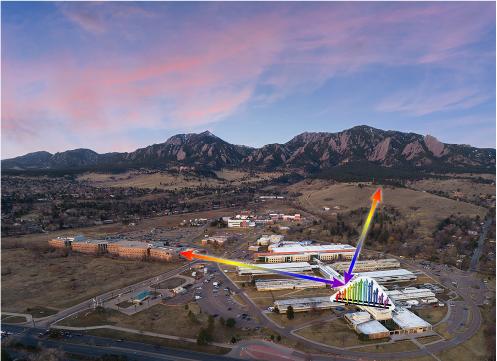
Credit: N. Hanacek/NIST
Researchers at the National Institute of Standards and Technology (NIST) have upgraded their laser frequency-comb instrument to simultaneously measure three airborne greenhouse gases — nitrous oxide, carbon dioxide and water vapor — plus the major air pollutants ozone and carbon monoxide.
Combined with an earlier version of the system that measures methane, NIST’s dual comb technology can now sense all four primary greenhouse gases, which could help in understanding and monitoring emissions of these heat-trapping gases implicated in climate change. The newest comb system can also help assess urban air quality.
These NIST instruments identify gas signatures by precisely measuring the amounts of light absorbed at each color in the broad laser spectrum as specially prepared beams trace a path through the air. Current applications include detecting leaks from oil and gas installations as well as measuring emissions from livestock. The comb systems can measure a larger number of gases than conventional sensors that sample air at specific locations can. The combs also offer greater precision and longer range than similar techniques using other sources of light.
NIST’s latest advance, described in a new paper, shifts the spectrum of light analyzed from the near-infrared into the mid-infrared, enabling the identification of more and different gases. The older, near-infrared comb systems can identify carbon dioxide and methane but not nitrous oxide, ozone or carbon monoxide.
Researchers demonstrated the new system over round-trip paths with lengths of 600 meters and 2 kilometers. The light from two frequency combs was combined in optical fiber and transmitted from a telescope located at the top of a NIST building in Boulder, Colorado. One beam was sent to a reflector located on a balcony of another building, and a second beam to a reflector on a hill. The comb light bounced off the reflector and returned to the original location for analysis to identify the gases in the air.
A frequency comb is a very precise “ruler” for measuring exact colors of light. Each comb “tooth” identifies a different color. To reach the mid-infrared part of the spectrum, the key component is a specially engineered crystal material, known as periodically poled lithium niobate, that converts light between two colors. The system in this experiment split the near-infrared light from one comb into two branches, used special fiber and amplifiers to broaden and shift the spectrum of each branch differently and to boost power, then recombined the branches in the crystal. This produced mid-infrared light at a lower frequency (longer wavelength) that was the difference between the original colors in the two branches.
The system was precise enough to capture variations in atmospheric levels of all of the measured gases and agreed with results from a conventional point sensor for carbon monoxide and nitrous oxide. A major advantage in detecting multiple gases at once is the ability to measure correlations between them. For example, measured ratios of carbon dioxide to nitrous oxide agreed with other studies of emissions from traffic. In addition, the ratio of excess carbon monoxide versus carbon dioxide agreed with similar urban studies but was only about one-third the levels predicted by the U.S. National Emissions Inventory (NEI). These levels provide a measure of how efficiently fuel combusts in emissions sources such as cars.
The NIST measurements, in echoing other studies suggesting there is less carbon monoxide in the air than the NEI predicts, put the first hard numbers on the reference levels or “inventories” of pollutants in the Boulder-Denver area.
“The comparison with the NEI shows how hard it is to create inventories, especially that cover large areas, and that it is critical to have data to feed back to the inventories,” lead author Kevin Cossel said. “This isn’t something that will directly impact most people on a day-to-day basis — the inventory is just trying to replicate what is actually happening. However, for understanding and predicting air quality and pollution impacts, modelers do rely on the inventories, so it is critical that the inventories be correct.”
Researchers plan to further improve the new comb instrument. They plan to extend the reach to longer distances, as already demonstrated for the near-infrared system. They also plan to boost detection sensitivity by increasing the light power and other tweaks, to enable detection of additional gases. Finally, they are working on making the system more compact and robust. These advances may help improve understanding of air quality, specifically the interplay of factors influencing ozone formation.
###
The work was funded by the Defense Advanced Research Projects Agency and the NIST Special Programs Office.
Paper: F.R. Giorgetta, J. Peischl, D.I. Herman, G. Ycas, I. Coddington, N.R. Newbury and K.C. Cossel. Open-path Dual-comb Spectroscopy for Multispecies Trace Gas Detection in the 4.5 μm to 5 μm Spectral Region. Laser and Photonics Review. Published June 30, 2021. DOI: 10.1002/lpor.202000583
Media Contact
Laura Ost
[email protected]




